
President Clinton today becomes the first president in eleven years to visit Colombia. He is making a brief stop off in Cartagena to symbolically deliver the $1.3 billion US aid package to President Pastrana to fight the so-called war on drugs. Against the wishes of human rights activists in Colombia and the United States, Clinton signed a waiver last week that allows the aid money to be delivered despite Colombia’s failure to meet six conditions in the aid package designed to protect human rights. The bulk of the $1.3 billion US aid package is earmarked for the Colombian military. This comes as the peace process between the Colombian government and rebel groups is at a standstill. [includes rush transcript]
Violence in Colombia has escalated dramatically in the last months. This past Sunday, twenty people were killed in two separate massacres attributed by news reports to paramilitaries. Ten were killed execution-style in Cienega, and ten men were taken from a pool hall and shot point blank, allegedly for being sympathizers of leftist rebels.
Guest:
- Mario Murillo, a longtime producer at Pacifica station WBAI. For years, he has produced and hosted the national weekly news magazine Our Americas. He just returned from spending the summer in Colombia.
Transcript
AMY GOODMAN:
President Clinton today becomes the first president in eleven years to visit Colombia. He’s making a brief stop off in Cartagena to symbolically deliver the $1.3 billion US aid package to President Pastrana to fight the so-called war on drugs.
Against the wishes of human rights activists in Colombia and the US, Clinton signed a waiver last week that allows the aid money to be delivered despite Colombia’s failure to meet six conditions on the aid package designed to protect human rights. The bulk of the $1.3 billion US aid package is earmarked for the Colombian military. This comes as the peace process between the Colombian government and rebel groups is at a standstill.
Juan, you did a piece for the New York Daily News today on Colombia. That’s the top story on the Common Dreams website.
JUAN GONZALEZ:
Yes. Well, actually it was yesterday that the piece came out. But, yes, I mean, basically I was just recapping in that column both the impact of what that aid will be on not just Colombia, but all the countries of the region, as well as the reaction of many in the Colombian community here in the United States, as there’s a growing peace movement among Colombians in this county trying to prevent the impact of the aid.
And we have to put this aid in context. $1.3 billion, that is more aid than the United States is giving to all of the rest of Latin America together. To give you a sense of the impact this is going to have on that country, the total national budget of Colombia is only about $30 billion. So this is an enormous — this is, in essence, the United States, through cash donations and through the helicopters it is giving to Colombia, being — in essence, taking over a lot of the Colombian military’s source of funding.
AMY GOODMAN:
This at a time as the violence increases, this past Sunday twenty people killed in two separate massacres attributed by news reports to paramilitaries, ten people killed execution-style in Cienega, and ten men were taken from a pool hall and shot point blank, allegedly for being sympathizers of rebels.
We’re joined by Mario Murillo, who has just returned from Colombia. He’s a longtime producer at Pacifica station WBAI and for years has produced and hosted the national weekly news magazine Our Americas.
Welcome to Democracy Now!, Mario.
MARIO MURILLO:
Thank you, Amy. It’s good to be here. Hi, Juan.
JUAN GONZALEZ:
Mario, tell us, in your visit, what were some of your — some of the things that you discovered that have been developing in Colombia now in the last few months?
MARIO MURILLO:
Well, I think the overall feeling right now is that, first of all, the situation is bound to get worse. Right now in the New York Times today, we see the reports of, you know, President Clinton giving a seven-minute address last night to national television in Colombia, talking about how they’re here to help. We’re neighbors and friends; we’re not here to intervene in any way. President Pastrana, meanwhile, was also turning it around and saying, well, this Plan Colombia will only work if the United States takes a serious effort at looking at not only eradication, but consumption at home. So they’re painting it really nicely.
But the fact of the matter is, is that, as you pointed out, that $1.3 billion in assistance, almost 82 percent of that is going directly towards the military. So the bulk of that aid, while they try to say it’s a social, economic assistance package that’s also going to help the justice system and all the other social components of Colombian society, the bulk of it is military.
And the majority of the people that I’ve spoken with — and I should point out that President Clinton is going to Cartagena, and he’s indicated last week, when I was still there, he was saying how “I want to see the true face of Colombia right now, and that’s why I want to go there. I don’t want to be interfered with.” First of all, they’re cleaning the streets like you wouldn’t believe in Cartagena to the tune of $7.5 million, so that’s the true face that they’re going to see. But if he really wanted to see the true face of Colombia, he wouldn’t go to Cartagena only. He would probably take a trip to Barranca, where the civilian population has been under siege by paramilitaries allied with the Colombian armed forces. He would go down to San Jose del Guaviare, for example, where I spent about a week there earlier this month, where I was speaking with — and this is the part of the country where the United States and the Colombian government started this so-called fumigation-eradication program in 1993 through 1997. That was the focus of that eradication program. And I’ve talked to dozens of people there, who are saying, “Well, what they’re going to do now with this Plan Colombia, which is in another part of the south of Colombia, they have already tried here, and it hasn’t worked.”
AMY GOODMAN:
You say Plan Colombia. That isn’t, I think, a common term for people in the United States.
MARIO MURILLO:
Well, Plan Colombia is basically like the Marshall Plan of President Pastrana. He’s been pushing this as the way of rebuilding the country after forty years of civil war, after internal conflict that has cost thousands and thousands of lives. And basically the idea is that, OK, well, Colombia has got a serious problem, but it cannot solve it by itself, and it has to incorporate the international community in one way or another. So the idea is, the budget for the Plan Colombia is about $7.5 billion, and the idea is that, OK, we’re going to get pledges from Washington, pledges from Europe, and then Colombia is going to match those pledges to try to deal with social development, alternative crop programs in the south, again, as I said, strengthening the institutions of government, etc. So that’s more or less what the idea of the Plan Colombia is, and again, they’re counting on Europe and the United States.
Needless to say, the United States component is primarily military, whereas Europe is mostly in the social area. And the idea is to eradicate coca from — for example, the plan specifies that within the next five years they’re going to be able to get rid of 50 percent of all coca cultivations in the country, which is practically impossible by all analyses that we’ve looked at, also that the way to strengthen democracy is to improve social programs in the countryside, etc., etc. But again, the focus that most people are talking about now is the United States component of that Plan Colombia, which is, as Juan just pointed out and as many critics have pointed out, is primarily a military program that is focused on, again, combating the southern — the stronghold of the guerrillas in the southern part of the country, which is, of course, a strong area of coca cultivation.
JUAN GONZALEZ:
Well, Mario, in terms of the coca cultivation, one of the things I think that has not gotten much attention is how this eradication program is going to create environmental problems. Brazil, for instance, has been protesting what the impact of massive spraying is going to do on the Amazon, because it’s in the southern area of Colombia where a lot of the spraying will occur. Can you talk a little bit about that?
MARIO MURILLO:
Well, the fact that — they call it a triple deforestation, three levels of deforestation. The first level, of course, is the fact that the campesinos, the poor peasants in that part of the country, are forced to eradicate — are forced to cultivate coca, because they have no other alternatives. I spoke to a number of people down there in San Jose who were talking about how they had no other options. They tried to grow yucca, they tried to grow bananas, and they basically had no other options but to grow the coca. So that’s the first. Obviously, they go into the jungle, they knock out a bunch of forest, and they start growing coca.
The second level of that deforestation is the fumigations, the eradication that comes, again, through the United States, primarily through the United States, that devastates the local environment, that poisons the environment.
And then, finally, the third level is, once these major crop cultivations are completely eradicated or completely poisoned, these campesinos are forced to knock down more forest, because they’re moving further away, to another level. And that’s basically what’s going to happen. This Plan Colombia seems to have not taken that reality into consideration, that this is inevitable it’s going to happen.
Now, I spoke with — I don’t know if we have time just to play this one cut. I have a lot of tape, and I hope to put some stuff together for Our Americas and perhaps here for Democracy Now!, as well. But I spoke to one person, Pedro Arenas, in San Jose. He’s a community activist. He’s a former councilmember in San Jose and an assembly member in El Guaviare, who’s now currently running for the mayoralty of San Jose, needless to say, with major risk because of his positions against the eradication program. In 1997, he was forced to leave the country for about two months because of his organizing of the campesino protests against the fumigation. And he was basically talking about how, once again, Plan Colombia, which is focused in Putumayo and other parts of the southern part of Colombia, has already been experimented on in San Jose and in Guaviare, and basically to very negative effects.
- [translating Pedro Arenas] He says that El Guaviare has been presented as an example of the eradication program, and it’s been used as an example of the effectiveness of the fumigation efforts spearheaded by Washington. It has been said that in El Guaviare province there is no coca right now and that the fumigations have been successful and that the cultivations have been terminated, which is clearly not the case. The government likes to say that there are no problems here anymore in Guaviare, but that’s simply not true. Here, the economy, like in other parts of Colombia, continues to be dependent on these illicit crops.
What has happened in recent years? Well, as he says, he says most of the attention now in Colombia is either in San Vicente del Caguan, which is where the Colombian military demilitarized the area to continue peace talks with the guerrillas of the FARC, and also they’re focusing on Putumayo, which is south of San Jose, where they’re going to focus on this Plan Colombia. And all the attention is now on those two areas. And as he argues, he says that they’re going down there to — you know, the media go down there to this demilitarized zone, and it’s like a safari, like a show for them, like a circus, because that’s where all the attention is. But the media is not looking at the old Hollywoods, as he points out, like El Guaviare, Miraflores, the former capital of cocaine, of coca. Nobody pays attention to what’s happening here. And basically, the fact of the matter is, is that the poverty, the displacement, the exclusion, the misery of the people continues to be an everyday part of the reality.
And I just want to add to that, you know, because, I mean, he says a lot more, when you talk to people, when you talk to young people especially, in that part of the country, they have no options. And they don’t think that the Plan Colombia is going to solve their problems.
They have two options: one, to get into the guerrilla, or two, get into the paramilitary, because there, then they’re going to have a gun, they’re going to have a uniform, they’re going to have a salary, and the paramilitaries pay up to 150,000 pesos a week, which is not so much, but considering the money that a regular peasant worker would get in that part of the country, it’s a lot of money. And basically that’s the only options they have. And again, the government, which always argues and has been arguing lately that the guerrillas control 60 percent of the territory or 40 percent of the territory, the fact of the matter is, is that the government has always neglected this part of the country, and now they’re starting to focus on it, but again, primarily through a military component.
AMY GOODMAN:
Is there a sense that the US is getting involved in an escalating civil war that the US is fueling?
MARIO MURILLO:
Well, I think one thing — I mean, this is one of the arguments I’ve always made, and I think a lot of people down there argue. In fact, Pedro Arenas, in the other cut, which we don’t have time to listen to, he says that this is nothing new, that in the United States they talk about a new intervention, as if it’s something that’s happening in the future, but it’s been going on for years. If we can talk about Kennedy and Johnson escalating the war in Vietnam, well, we can talk about Kennedy and Johnson escalating the war in Colombia. And I think the same thing — and now you’re seeing people paying attention to it, but the fact of the matter is, is that the military presence of the United States in Colombia has always been there. The training, the manipulation of the internal conflict has always been there as part of the United States. Now it’s just more pronounced.
JUAN GONZALEZ:
And, of course, one of the arguments that you hear from the Clinton administration is that the human rights violations of the Colombian army have gone down. It used to be that the army was accused of about over 50 percent of all the human rights violations; now it’s down to a few percent. But the problem is that the paramilitaries, they’ve escalated to almost 75, 78 percent of all of the human rights violations. And we’ve seen the situation before. We saw it in Haiti with the FRAP. We saw it in Salvador with Roberto d’Aubuisson’s right-wing squads. And we saw it in Timor with the civilians. When the military wants to get the heat off of itself, a repressive military, it just spawns unofficial right-wing groups that do the killing, the dirty war for them.
MARIO MURILLO:
Mm-hmm. And while there is some lip service carried out against the paramilitaries, the attention constantly is on the FARC, the attention of all the violence and all the actions that are being carried out against the civilian population. If you look at El Tiempo or La Espectador, the major dailies, every day you’ll have a huge headline of an attack on a police base or something by the FARC or by the guerrillas, and then you’ll have a very small headline, “Four Campesinos Massacred by the AUC,” the paramilitary group. And that’s the constant drumbeat that we hear over and over again. The paramilitaries are a problem, but the guerrillas are the serious problem in Colombia.
AMY GOODMAN:
And that’s the refrain of the press. Well, I want to thank you very much, Mario Murillo, for joining us, and we really look forward to your documentary and playing it also on Democracy Now!, what is happening in Colombia today. Mario Murillo is a professor at Hofstra University in Long Island, New York, a professor of communications, and a longtime producer at Pacifica station WBAI and the national radio program Our Americas.

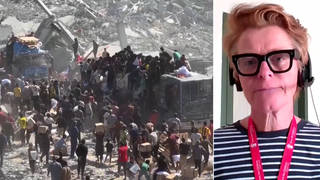
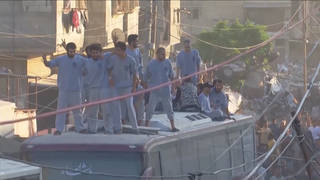
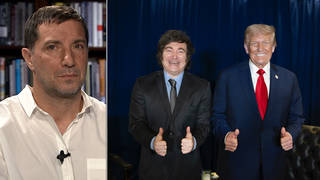






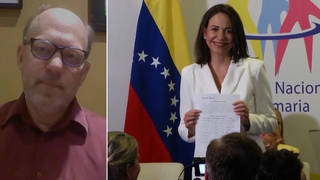
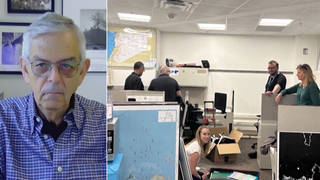
Media Options